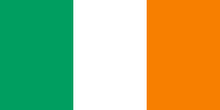
Ireland was mostly ice-covered and joined by land to Britain and continental Europe during the last ice age. It has been inhabited for about 9,000 years. Stone age inhabitants arrived sometime after 8000 BC.
According to early medieval chronicles, in 431, Bishop Palladius arrived in Ireland on a mission from Pope Celestine to minister to the Irish "already believing in Christ." The same chronicles record that Saint Patrick, Ireland's patron saint, arrived in 432.
The druid tradition collapsed in the face of the spread of the new religion. Irish Christian scholars excelled in the study of Latin and Greek learning and Christian theology in the monasteries that flourished, preserving Latin and Greek learning during the Early Middle Ages. The arts of manuscript illumination, metalworking, and sculpture flourished and produced such treasures as the Book of Kells, ornate jewellery, and the many carved stone crosses that dot the island. This era was interrupted in the 9th century by 200 years of intermittent warfare with waves of Viking raiders who plundered monasteries and towns. Eventually they settled in Ireland and established many towns, including the modern day cities of Dublin, Cork, Limerick and Waterford.In 1171, King Henry II of England (an Angevine King, son of Geoffrey the Handsome - really - GT12) invaded Ireland, using the 1155 Bull Laudabiliter issued to him by then English Pope Adrian IV to claim sovereignty over the island, and forced the Cambro-Norman warlords and some of the Gaelic Irish kings to accept him as their overlord. From the 13th century, English law began to be introduced. By the late thirteenth century the Norman-Irish had established the feudal system throughout most of lowland Ireland. Their settlement was characterised by the establishment of baronies, manors, towns and large land-owning monastic communities.
From the late fifteenth century English rule was once again expanded resulting in the complete conquest of Ireland by 1603 and the final collapse of the Gaelic social and political superstructure at the end of the 17th century, as a result of English and Scottish Protestant colonisation in the Plantations of Ireland, and the disastrous Wars of the Three Kingdoms and the Williamite War in Ireland.After the Irish Rebellion of 1641, Irish Catholics were barred from voting or attending the Irish Parliament. The new English Protestant ruling class was known as the Protestant Ascendancy. Towards the end of the 18th century the entirely Protestant Irish Parliament attained a greater degree of independence from the British Parliament than it had previously held.
Under the Penal Laws no Irish Catholic could sit in the Parliament of Ireland, even though some 90% of Ireland's population was native Irish Catholic when the first of these bans was introduced in 1691. This ban was followed by others in 1703 and 1709 as part of a comprehensive apartheid system against the community, and to a lesser extent against Protestant dissenters.[16] In 1798 many members of this dissenter tradition made common cause with Catholics in a rebellion inspired and led by the Society of United Irishmen. It was staged with the aim of creating a fully independent Ireland as a state with a republican constitution. Despite assistance from France the Irish Rebellion of 1798 was put down by British forces.In 1800 the British and subsequently the Irish Parliament passed the Act of Union which, in 1801, merged the Kingdom of Ireland and the Kingdom of Great Britain to create the United Kingdom of Great Britain and Ireland. According to contemporary documents the necessary majority in the unrepresentative Irish Parliament was achieved by means of bribery. Thus Ireland became part of an extended United Kingdom, ruled directly by the UK Parliament in London.
The 19th century saw the Great Famine of the 1840s, during which one million Irish people died and over a million emigrated. Mass emigration became entrenched as a result of the famine and the population continued to decline until late in the 20th century. The pre-famine peak was over 8 million recorded in the 1841 census. The population has never returned to this level.
The 19th and early 20th century saw the rise of Irish Nationalism especially among the poorer Catholic population. Daniel O'Connell led a successful non-violent campaign for Catholic Emancipation. A subsequent campaign for Repeal of the Act of Union failed. Later in the century Charles Stewart Parnell and others campaigned for self government within the Union or "Home Rule". This was also unsuccessful. These failures resulted in the eclipse of moderate nationalism by militant separatism.
In 1921, following the Easter Rising of 1916, and the subsequent Irish War of Independence, a treaty was concluded between the British Government and the leaders of the Irish Republic. The Treaty recognised the two-state solution created in the Government of Ireland Act 1920. Northern Ireland was presumed to form a home rule state within the new Irish Free State unless it opted out.
Northern Ireland had a majority Protestant population which feared becoming a minority in a majority Catholic state. Not unexpectedly it opted out of the new state and chose instead to remain part of the United Kingdom. A Boundary Commission was set up to decide on the boundaries between the two Irish states, though it was subsequently abandoned after it recommended only minor adjustments to the border.
Disagreements over some provisions of the treaty led to a split in the Nationalist movement and subsequently to the Civil War. The civil war ended in 1923 with the defeat of the Anti-treaty forces.






No comments:
Post a Comment